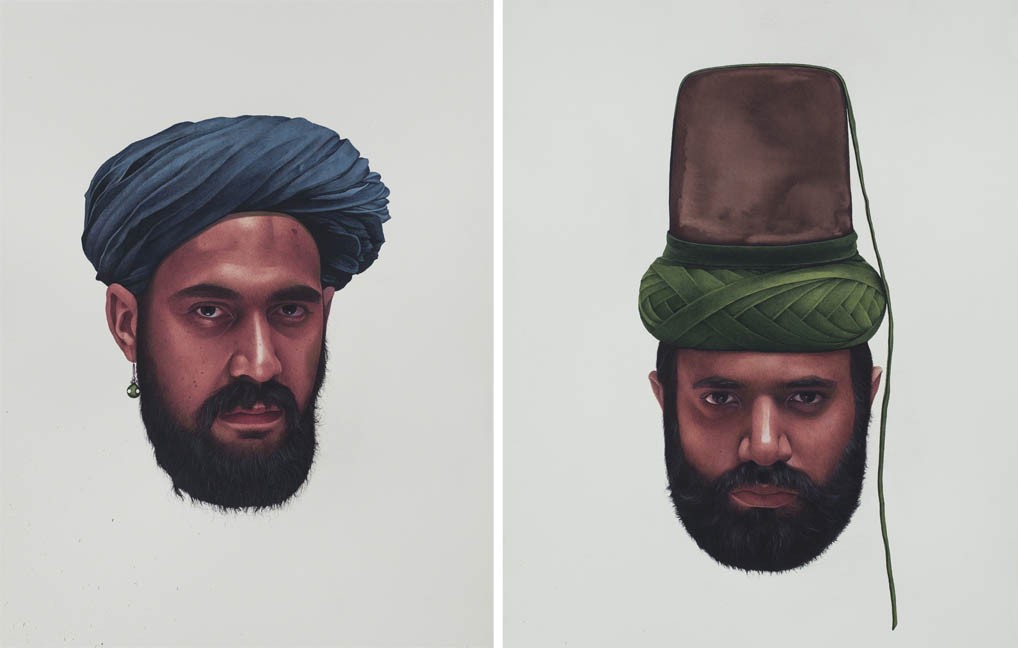
In his recent exhibition at O Art Space, Lahore, Irfan Hasan has drawn portraits inspired by Abul Hasan Ghaffari

In the coming years, people would long for pictures printed on paper. Photographs that were shot, developed, collected and preserved in family albums. Or picture of a face pasted on identity cards, passports, or placed inside a wallet often secretly. Because, in today’s digital world, printed photographs are already a rarity.
John Berger, writing on the link between photography and the art of painting, in his essay The Changing View of Man in the Portrait, observes: "The beginning of the decline of the painted portrait coincided roughly with the rise of photography.….. Photography was more accurate, quicker and far cheaper. To counter the clear logic of this argument, painters and their patrons invented a number of mysterious, metaphysical qualities with which to prove that what the painted portrait offered was incomparable. Only a man, not a machine (the camera), could interpret the soul of a sitter."
Berger remarked about a phenomenon from more than a hundred years ago, of mid nineteenth century. But it seems to be occurring again in contemporary times. With the advent and popularity of digital image, it is seldom that one gets a portrait preserved on paper or on any tangible surface. Unless of course if it’s painted by an artist like Irfan Hasan. Trained as a miniature painter at the National College of Arts, Lahore (2002-2006), Hasan excelled in the technique of observation and sophistication in rendering fine details. These are qualities that marked all his work, regardless of their scale, style or scenarios.
Like every important artist, Hasan’s work has undergone various stages, some sudden, some subtle, from surrealistic to fantastical mode, but recently it has attained a specific sensibility. One finds a sense of meditation (the term popular among contemporary miniature painters!) in his aesthetics. It does not amount to spirituality or sacredness; his focus is more of a person engaged in formal concerns. Through form, he discovers and delineates a state that, in Berger’s words, harks back to the painters’ stance of infusing an element beyond appearance -- the psychological self, a character really.
In his new body of works, (Traces of Ghaffari exhibited from Dec 9-22, 2017 at O Art Space, Lahore) Hasan has drawn faces of individuals he encountered for varied lengths of time. A soldier seen at a faraway post, friends and fellow artists, students, his studio assistant: all transform into personalities belonging to more than one region or period.
Portraiture is conventionally considered to be a true picture of the person, capturing and conveying his individuality and identity. The idea of identity is based on the presumption of uniqueness of a person. Yet one forgets that the name, features, and physique that shape an individual’s identity are not exclusive, these recur at multiple points in history. So a name or a face recognised by many -- often across countries -- is in reality merely a repeated version of someone who had lived before. There may be many Mohammad Iqbals, Shakir Alis, Intizar Husains, Noor Jahans, Abida Parveens, Wasim Akrams, Reshams and Fawad Khans. Likewise, the features one presumes to be so personal and private can be the copy or combination of one’s ancestors, near or distant (this includes the whole of humanity which shares a single forefather).
Irfan Hasan investigates this notion of multiple identities in his work when he bestows a specific character to his models in his immaculately executed works. These portraits define the composite nature of a man who -- like a good internet device -- is always connected with those sites and souls which are beyond his reach or realisation. By transforming people -- whom we cross on road, meet at our work place, ignore at the opening of an exhibition, avoid at a police checkpoint -- into characters which represent parallel realities, is a far superior feat of a painter who has the ability to mesmerise an ordinary viewer with the superiority of his craft.
So, his models, who emerge from our environment and are diverse (from an ordinary guard to the grandson of first elected prime minister of Pakistan), reveal their outer selves as well as their alter egos, hidden, buried, neglected and forgotten in the heap of their fears and familiarities. With these subjects, he comments on many aspects of our contemporary existence -- understood through the mirror of history or the lens of faith. Thus, the mark of a pious person on the forehead is added on the face of an artist; headgear from Ottoman Empire is put on a youth who is seeking a career in art, another traditional cap is placed on a student pursuing music.
But each segment of our existence is a testimony of a greater game of globalisation in which nations, communities, and ethnicities have been participating. The interaction between cultures that enriches civilizations has been a phenomenon that may be traced from the times of Indus Valley Civilization, Mesopotamian period and Egyptian kingdoms. In the art of Irfan Hasan, one glimpses that exchange in different terms. The artist has been inspired and influenced by Abul Hasan Ghaffari, the court painter of Naseer Uddin Shah Qajar from late seventeenth century. The master of the traditional art of Persian miniature painting travelled to Europe, studied western painting and incorporated ingredients of ‘representational scheme’ in conventional practice of eastern painting. Thus, his work is a semblance of a site where east meets west, while both locations diffuse their differences.
During his participation in the Second Rybon International Artist Workshop in collaboration with Kooshk Residency and Deegar Platform, Hasan had the chance to study the original works of Abul Hasan Ghaffari. This experience modified, rather enhanced, his pictorial choices. So his portraits are not about people made of flesh and bones, but of characters stepping out of their makers’ imagination, as well as heirs to that Abul Hasan’s legacy who is reliving in our own Irfan Hasan.